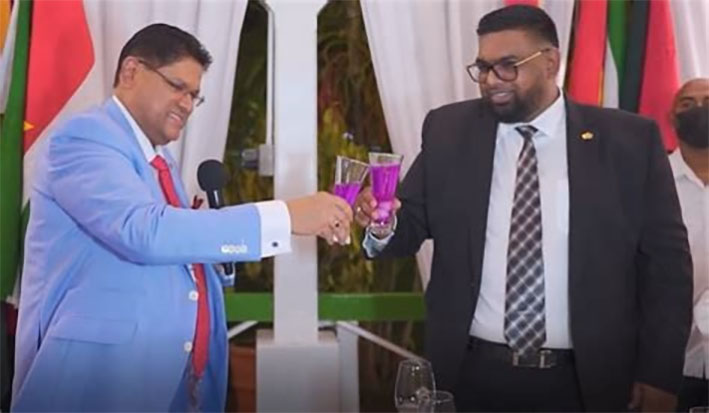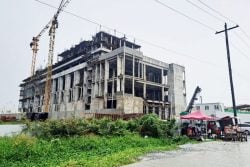Long regarded as being among the underachievers within a wider South American family, Guyana and Suriname are seemingly in the process of ‘coming through’, courtesy of oil discoveries that will potentially bring about major economic transformation to a wider South American ‘family’ others of which have long now reaped the benefits of the hemisphere’s enormous oil reserves.
First Guyana, and more recently, Suriname arrived there too late to avoid decades of crippling poverty but both now are beginning to feel a sense that the ‘worm is turning’. Guyana arrived at that point of euphoria, first, when, back in May 2015, ExxonMobil made public a “significant oil discovery” offshore Guyana. In February 2023 the French company, Total, announced its own major petro breakthrough offshore Suriname. Both countries have now put in their separate appearances at South America’s petro party seemingly positioned to participate actively in a game of ‘catchup.’
 Such is the capacity of oil to accelerate growth that, in Guyana, signs are already beginning to appear that while not nearly enough has been done, up to this time, to significantly alter the protracted standard of living deficit of the country’s poor, the optics linked to an emerging, mostly coastal urban infrastructural ‘makeover’. Suriname’s more recent disclosure of its oil fortune, courtesy of the French Company Total, has created a lesser continental fuss than that which ensued when ExxonMobil made its own ‘noises’ following its 2015 find, offshore Guyana. Together, the two developments have sent a compelling signal that where the coming of age of the two countries are concerned, the portents for profound socio-economic transformation loom large.
Such is the capacity of oil to accelerate growth that, in Guyana, signs are already beginning to appear that while not nearly enough has been done, up to this time, to significantly alter the protracted standard of living deficit of the country’s poor, the optics linked to an emerging, mostly coastal urban infrastructural ‘makeover’. Suriname’s more recent disclosure of its oil fortune, courtesy of the French Company Total, has created a lesser continental fuss than that which ensued when ExxonMobil made its own ‘noises’ following its 2015 find, offshore Guyana. Together, the two developments have sent a compelling signal that where the coming of age of the two countries are concerned, the portents for profound socio-economic transformation loom large.
It will be recalled that in the wake of Guyana’s 2015 oil find and the country’s move to send suitable messages to the rest of the hemisphere there occurred an unprecedented outbreak of closeness between Guyana and Suriname, the former, at that time, seeking to use its oil discoveries to strengthen its foreign policy platform and the latter, more than a little hopeful that its turn was just around the corner anxiously holding its breath. While the relationship between the two countries is still occasionally rattled by the relatively mild tremors of the Corentyene River dispute there has never in recent years, been any worrying indication that the two countries are about to seriously ‘lock horns’ over the river which they share. At any rate, both Georgetown and Paramaribo remain acutely aware of the fact that (as we say in Guyana) they now have ‘bigger fish to fry.’
If the strong diplomatic embrace of a few years ago, led by Presidents Irfaan Ali and Chandrikaprasad Santoki appears somewhat diluted, of late, that is because with the maximizing of the likely petro returns for both countries on their respective agendas, preoccupation with the Corentyne river have diminished though not dissolved. What has emerged, in the meantime, is a Suriname-Guyana Chamber of Commerce (SGCC) which marked its first anniversary on August 31 and which appears to be positioning itself to become “a key player in regional economic development.”
While, in the short term at least, the ambitions of the newly established Chamber appear more than a trifle exalted there can be no mistaking the fact that when a Guyana/Suriname investment/development agenda seriously comes to the fore the private sector in both Georgetown and Paramaribo will be seeking prominent seats at the negotiating table. If the Chamber’s reported statement that since its very recent advent it has become ‘a key player in regional economic development’ is probably somewhat overdone, there can be no question than that given the proximity between the two countries and the already pre-existing business ties at the private sector level the SGCC and other such business support organizations that are likely to mushroom between the two countries could seize the significant initiative arising from the petro-fortunes of the two countries to create the formal private sector ties that could strengthen business links between them.
The potential significance of the SGCC is reflected in the fact that both Guyana, through Foreign Secretary Robert Persaud and Suriname, through that country’s Business, and International Co-operation Minister, Albert Ramdin have endorsed the launch of the SGCC on behalf of their respective governments. These developments likely send signals that the still prevailing Corentyne River dispute will not, at least in the immediate term, place constraints on business relations between the two countries where accelerated bridge-building is concerned. While the view had been posited (by the Stabroek Business) back in September last year that Suriname’s major oil find delay may have created a gap in the process of strengthening of relations between the two countries, Suriname’s recent major oil find would appear to have re-opened opportunities for the bilateral prospects that had earlier been envisaged by Presidents Ali and Santoki during the discourses arising out of their respective visits to Georgetown and Paramaribo during the earlier period of energetic cross-border diplomacy.




